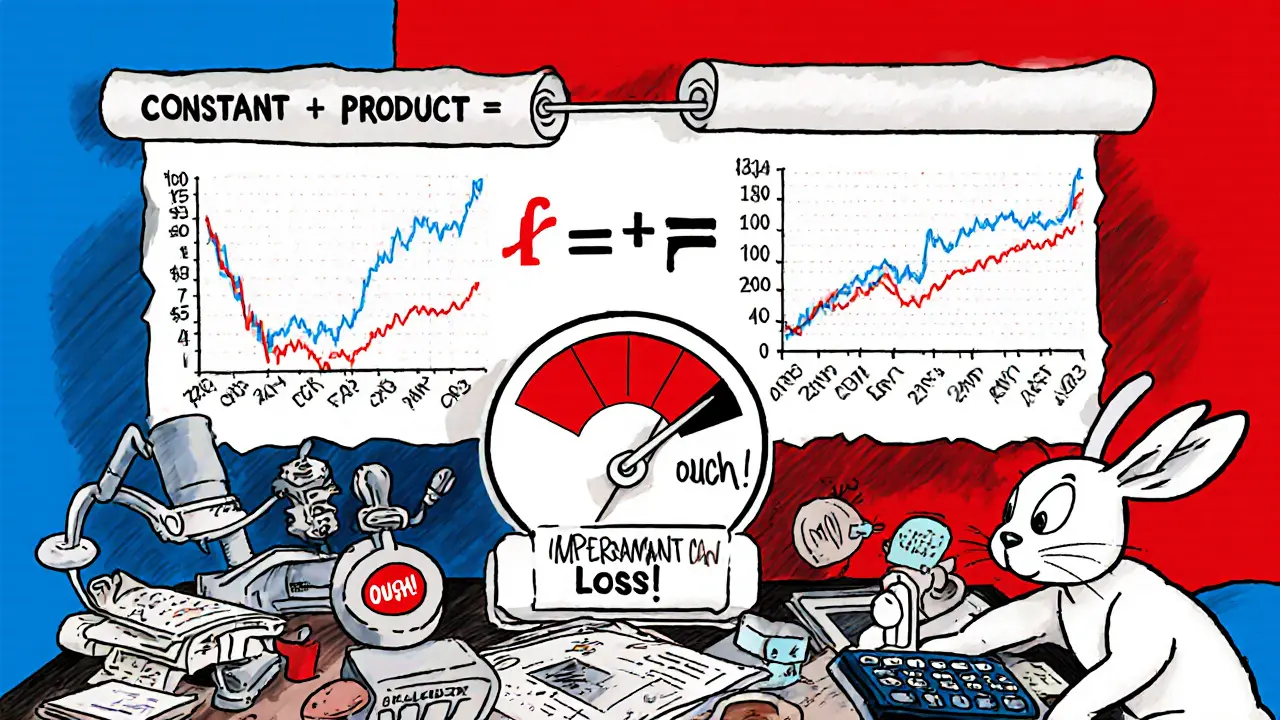
Impermanent Loss Calculator
Results
When you hear the term Impermanent Loss a temporary reduction in the value of assets supplied to an automated market maker (AMM) pool compared to simply holding those assets, the first reaction is often "why would anyone risk that?" The short answer: LPs earn trading fees a slice of every swap that occurs in the pool, usually between 0.1% and 1% of volume and may also collect governance token rewards. If the fee income and rewards outweigh the loss, the strategy can still be profitable. This article breaks down how impermanent loss works, shows you how to calculate it, and gives practical ways to keep it in check.
Why Impermanent Loss Exists: The AMM Mechanic
At the heart of the phenomenon is the Automated Market Maker a smart‑contract algorithm that sets token prices by maintaining a constant product (x*y=k). When you become a Liquidity Provider someone who deposits a pair of tokens into an AMM pool and receives LP tokens representing a share of that pool, you must add the assets in a prescribed ratio-most commonly 50:50 by value. Every time a trader swaps one token for the other, the pool’s balances shift, automatically adjusting the price inside the contract. If the external market price diverges from the pool’s internal price, your share of the pool ends up containing a different ratio than when you entered, which is where the loss originates.
Step‑by‑Step: Calculating Impermanent Loss
- Identify the initial price ratio of the two assets when you deposit. For example, 1ETH = 100DAI.
- Track the price change of each asset relative to the other. Suppose ETH rises to 150DAI, a 50% increase while DAI stays flat.
- Apply the constant‑product formula to find the new pool composition. The math shows you now own less ETH and more DAI than you would have by simply holding.
- Calculate the value of your new holdings at the current market price.
- Subtract this value from the value you would have if you had kept the original assets. The difference is the impermanent loss.
In practice, most people use online calculators-these plug the price percentages into the standard impermanent‑loss equation:IL = 2√(p)/(1+p)-1, wherepis the price ratio change. The result is expressed as a percentage of the original capital.
How Bad Can It Get? Real‑World Example
Imagine Alice adds 1ETH (worth $100) and 100DAI to a Uniswap pool, giving her a 10% share of a $2,000 pool. If ETH jumps to $200 while DAI stays at $1, the price ratio has doubled. The impermanent‑loss formula yields about 8.5% loss. Alice’s share is now worth roughly $1,830 instead of $2,000-a $170 shortfall compared to simply holding the 1ETH and 100DAI. If the pool’s accumulated fees over that period total $30 and she also earns a governance token worth $20, she still ends up $120 behind a hold‑strategy. The loss becomes permanent the instant she withdraws.
Which Pools Are Safer? Stablecoin vs. Volatile Pairs
Not all pools expose you to the same risk. Stablecoin pairs (e.g., USDC/USDT) move in lockstep, so price divergence is minimal and impermanent loss is almost negligible. Volatile pairs (e.g., ETH/BTC) can see large swings, leading to substantial loss if one asset outperforms the other.
| Attribute | Stablecoin Pair (USDC/USDT) | Volatile Pair (ETH/BTC) |
|---|---|---|
| Typical Price Divergence | <0.5% | 5%-200% |
| Average Impermanent Loss (6‑month) | ~0.1% | 2%-15% |
| Annualized Trading Fees | 0.2%-0.5% | 0.5%-1.5% |
| Typical LP Reward Tokens | Low‑medium (e.g., UNI) | High (e.g., SUSHI, BAL) |
| Best For | Risk‑averse, income‑focused LPs | Yield hunters comfortable with price risk |

Mitigating Impermanent Loss
Several strategies help keep the loss from eating your profits:
- Choose low‑correlation pairs. Stablecoins, wrapped assets, or tokenized fiat pairs keep the price ratio tight.
- Provide liquidity within a Concentrated Liquidity a Uniswap V3 feature that lets you allocate capital to a narrow price range, reducing exposure to large swings band.
- Target pools with higher fee tiers (e.g., 0.3% or 1%) so fee earnings offset potential loss.
- Layer LP tokens into Yield Farming staking LP tokens in a separate contract to earn extra reward tokens. Extra rewards can tip the balance in your favor.
- Buy Insurance protocols like Nexus Mutual that offer coverage for impermanent loss in exchange for a premium. It’s an extra cost, but it caps downside.
- Monitor gas fees. On congested networks like Ethereum, high gas can erode profits. Consider layer‑2 solutions (Arbitrum, Optimism) where fees are lower.
When to Walk Away: Break‑Even Analysis
Every LP should calculate the point where cumulative fees + rewards equal the projected impermanent loss. A simple rule of thumb: if you expect the pool’s annualized fee rate to be at least double the expected impermanent‑loss percentage, the position is likely worthwhile. For example, in a volatile ETH/BTC pool with an estimated 6% loss over six months, you’d need at least a 12% fee return plus rewards to break even.
Future Outlook: Reducing the Risk
New AMM designs are actively trying to shrink impermanent loss. Uniswap V4 introduces customizable hooks that let developers embed fee‑adjusting logic directly into the pool contract. Curve’s stable‑swap algorithm already minimizes loss for assets that trade near parity. Insurance products from Nexus Mutual a decentralized cover platform that lets users purchase loss‑protection policies are gaining traction, though premiums can be high. As the ecosystem matures, we’ll see more dynamic fee structures and hybrid models that blend order‑book elements with AMM pricing-potentially eradicating the loss for many everyday LPs.
Quick Takeaways
- Impermanent loss occurs when price ratios shift in an AMM pool, reducing the value of your LP share.
- Stablecoin pools have minimal loss; volatile crypto pairs can suffer double‑digit percentages.
- Calculate loss using the standard formula or an online calculator before committing capital.
- Earn enough fees, rewards, or use insurance to make the strategy profitable.
- Stay updated on newer AMM designs-concentrated liquidity and dynamic fees can dramatically lower risk.
Frequently Asked Questions
What exactly is impermanent loss?
It is the temporary reduction in the USD value of assets you supplied to a liquidity pool, measured against the value you would have if you simply held those assets in a wallet. The loss becomes permanent if you withdraw before the price ratio returns to its original state.
How can I calculate it manually?
Take the price change ratio (p). Plug it into the formula IL = 2√p/(1+p) - 1. The result is a percentage. Multiply that by the value of your initial deposit to get the dollar loss.
Are stablecoin pools safe from impermanent loss?
They have very low exposure because the two assets stay at a 1:1 peg. The loss is usually under 0.2%, making them popular for risk‑averse LPs.
Can I protect myself with insurance?
Yes. Protocols like Nexus Mutual and Cover Protocol sell IL‑protection policies. You pay a premium, and if you withdraw at a loss, the insurer pays out up to the covered amount.
When is it worth providing liquidity?
When the expected annualized fee return plus any token rewards exceeds twice the projected impermanent loss. In practice, that means targeting pools with high volume, low price volatility, or generous reward programs.





